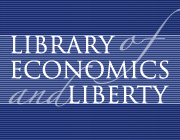
Arthur Frank Burns |

A later book, Measuring Business Cycles, coauthored with Wesley Mitchell, was a massive empirical study of previous business cycles. Burns and Mitchell distilled a large number of statistical indicators of recessions and expansions into one signal of turning points in the U.S. business cycle. Their book was published by the National Bureau of Economic Research, a private nonprofit research institute. The NBER is now the organization that announces when recessions begin and end. Much of NBER's approach is based on work done by Burns and Mitchell. Their book, more than any other single accomplishment, gave Burns a reputation as an expert in business cycle forecasting.
Burns earned all his degrees at Columbia University and did all his teaching there. From 1953 to 1956, he was chairman of President Eisenhower's Council of Economic Advisers. From 1957 to 1967, he was president of the NBER, and in 1959, president of the American Economic Association. From 1981 to 1985 Burns was the U.S. ambassador to the Federal Republic of Germany.
(With W. C. Mitchell.) Measuring Business Cycles. 1946.
Production Trends in the United States since 1870. 1934.
